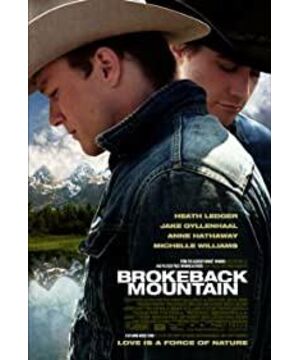"There is a little open space between what he knows and what he is trying to believe, but he can't do anything about it. Besides, since it can't be filled, he has to grit his teeth."
The ending of Anne Proud's novel is as depressing and vigorous as the style of the whole novel, like a layer of ice covering a fire, through the cold and restrained text to touch the hot emotions, it is hard to let go of it. The novel bears a distinctive geographical imprint, which makes people feel that even though their people and things happen in a time and space that has nothing to do with me, they are real. In terms of form, it seems to be close to minimalism, and the prose style also makes the description of the characters' psychology and emotions more free, which is an excellent condition for imaging. Coupled with Ang Lee's consistent delicacy, the film won two awards for "Best Director" and "Best Adapted Screenplay" that year. In my opinion, the adaptation of the film can be roughly summed up in the six words of faithfulness, precision and conciseness.
The first is faithfulness. It is worth mentioning that the overall tone of the movie is not the same as that of the novel. The text of the novel is bitterly cold, while the magnificent scenery of the green mountains and beautiful waters in the movie dilutes the severe cold of Wyoming, and even the melancholic tone of the guitar is also Feelings are born out of grief. But as far as the adaptation of the play is concerned, it can be said to be absolutely faithful. On the one hand, the narrative framework is almost completely in accordance with the novel, with no extra branches. On the other hand, the movie has a good restoration of the details in the novel, and many lines basically copy the original text. Of course, if the language of non-fiction is very refined, this is very difficult to do.
The second point is precision. As large as the space occupied by each scene, as small as the entry point of each guitar, everything is unfolded according to a meticulous arrangement, and there is no need to write. The most important thing here is the director's control and the actors' control over the characters. Take the climax scene when the two people parted for the last time as an example. The distance between the two of them is stretched farther, closer, further farther, and then closer... The simple front and back shots become more attractive in this repeated pulling. endless. The first time I pulled away was Jack’s anger and dissatisfaction with them for a long time, and then Ennis gradually approached to explain his difficulties, until the Mexican incident aroused a new conflict between the two, Ennis stepped forward and accused Jack. Angrily walked away again, followed by Jack's wonderful monologue. In this front and back shot, Jack is behind the mountains and lakes and the beauty of Brokeback Mountain, while behind Ennis is their car and the way to leave, which vividly shows the difference between the two of them-Jack is striving for A free and beautiful life in his own ideal, and Ennis has never been able to get rid of the secular vision and the fetters of reality. In the process of accusing Jack gradually approached, Ennis turned around when the camera shot back again, and the gap between the two was released to the maximum. And when Jack walked away again and said "I wish I knew how to quit you.
Finally, brevity. This is the highest state of literature as well as video. "Brokeback Mountain" reminds me of Bergman's movie "Marriage Life". Both of them compress a 20-year relationship into just a few hours. In terms of length, the former is undoubtedly more streamlined. I use the term "compression" to highlight the time span of the film with its limited space. In fact, it is not compression, but "refinement." (Some people think that feelings develop too quickly, but the intention of the film is not to explore the causes of feelings.) For "Brokeback Mountain", which has a text to follow, it does a faithful adaptation. In addition to the high degree of focus on the text, the internal processing of the scene is also as rare as possible. For example, in the opening paragraph, Jack peeped at Ennis through the rearview mirror. This brief glance created ambiguous tension and the character's excited, nervous, and cautious psychology. The rearview mirror appeared once again afterwards, and it was still Jack's peeping at Ennis, expressing parting reluctance. Such brevity implies a certain implicit restraint.
For another example, Jack drove to meet Ennis but was rejected. The scenes of Jack's coming and going are almost the same, and Jack's demeanor is in sharp contrast. Such straightforward processing ensures the efficiency of the narrative.
In addition, the film does not have a formal prologue or transition, and does not express the passage of time, so the change of the scene may mean an interval of months or even years without warning (Ennis’s daughter suddenly grew up ten How old are). The large interval ensures the blank space, and the clean transition also has a powerful effect. For example, from Ennis vomiting on the roadside to his wedding ceremony, the two emotions are completely opposite, making the audience involved in the aftertaste. In the next scene, the aftertaste of each segment is accumulated and delayed until the end of the whole film.
Some movies never go out of style, because emotions never go out of style. "Brokeback Mountain" is such a movie, which makes me feel endless after revisiting it after many years.
View more about Brokeback Mountain reviews











